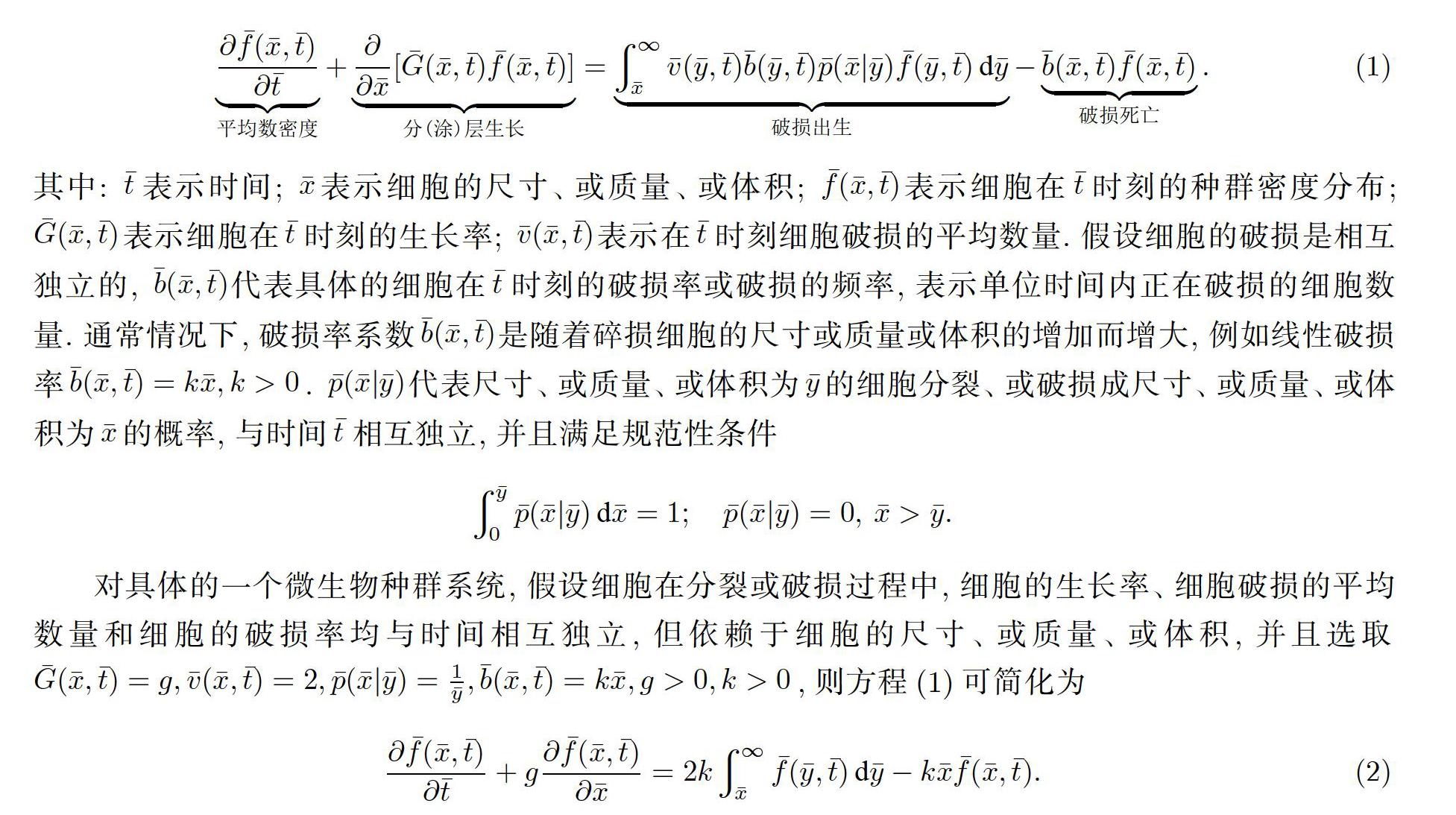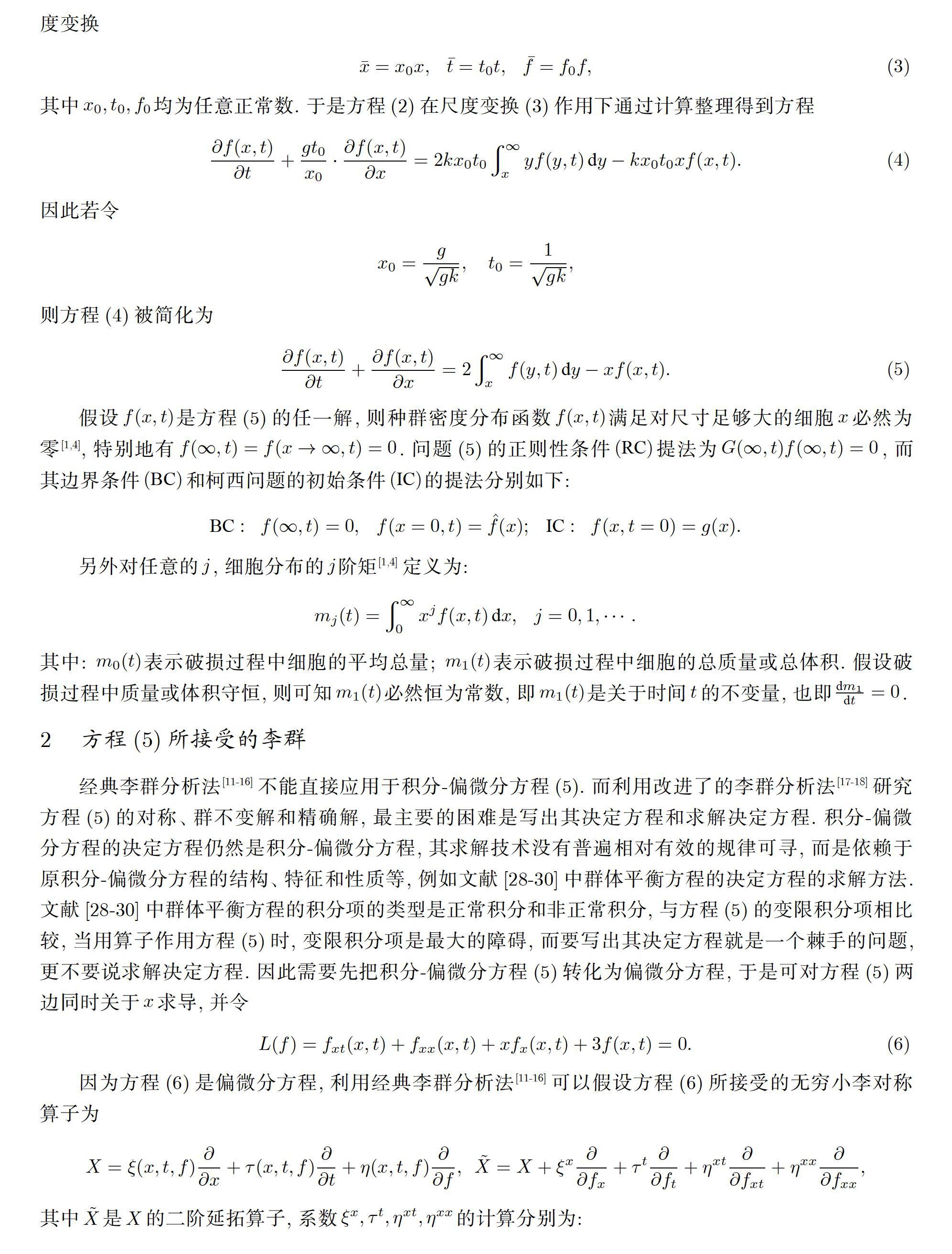一类群体平衡方程的李群分析及精确解
2020-04-10林府标张千宏
林府标 张千宏



摘要:探求一类群体平衡方程的显式精确解.首先将群体平衡方程转化成偏微分方程,利用经典李群分析法获得了偏微分方程的对称,进而得到了群体平衡方程的对称、最优化子李代数系统、约化的常微分一积分方程、群不变解及精确解.其次采用试探函数法找到了约化的常微分一积分方程的部分精确解,最后得到了群体平衡方程的部分显式精确解.
关键词:群体平衡方程;李群分析法;试探函数法;群不变解;精确解
中图分类号:0175.5; 0175.6
文献标志码:A
DOI: 10.3969/j.issn.1000-5641.201911008
0 引言
群体平衡方程可用于描述许多实际的自然实体或化学过程,如矿石或固体的粉碎,高分子的聚合,云的形成,细胞动力学行为等[1-6].固体材料的破碎、粉碎、尺寸减缩就是微粒系统中粒子的破损过程.细胞的二等分裂方式就是细菌种群的繁殖生长和破损过程.研究微生物种群动力学行为过程的群体平衡方程[1]可以写成
在实际工业应用领域中最主要的困难不是如何建立一个实体破损过程模型,而常常是没有精确求解这些实体模型的技术和方法,除非采用数值解法[1-7].为了精确描述、解释、理解和应用某些实体模型,探求偏微分方程、积分一偏微分方程的精确解以及研究精确求解技术是有实际研究价值和应用意义的[8-9].
群体平衡方程[1]是既含偏微分项又含多种类型的强非线性积分项以及代数方程项的积分一偏微分方程,要找到精确解一般都比较困难.极少数的群体平衡方程能通过某些变换转化为常微分方程求解[10].为了丰富和发展精确求解群体平衡方程的理论和方法,探究更多的精确解和解析求解的新方法是有必要和具有实际研究意义的.虽然经典李群分析法[11-16]不能直接用于群体平衡方程,但近年来改进了的李群分析法[17-181已被用于精确求解积分一偏微分方程、时滞微分方程和随机微分方程[19-25].
经典李群分析法[11-16]不能直接被用于探求积分一偏微分方程(1)和(2)的精确解.从微分代数的观点来看,其主要障碍是变限积分项在可微函数向量空间没有直接定义[14,15].因此,当把方程(1)和(2)的决定方程分解成超决定方程时,经典李群分析法失效了.采用改进了的李群分析法[17-18]寻找积分一偏微分方程(1)和(2)的精确解的最大困难是写出其决定方程和求解其决定方程,如何处理变限积分项是一个棘手的问题.
本文主要利用量纲分析法、试探函数法和经典李群分析法[11-16]间接探求群体平衡方程(2)的显式精确解,特别是满足实际问题的显式精确解,分析显式精确解所满足的边界条件、柯西问题的初始条件以及细胞种群密度分布的动力学行为特性.希望找到的显式精确解一方面可用于检验数值解的正确性和精确度,另一方面可为实体模型提供理论依据和参考.
1 因次分析和矩
许多具有实际应用背景的微分方程中往往带有常数因子,这些常数因子在精确求解过程中有时非常繁琐,既增加了计算量又不简洁.为了精确求解的方便,可以利用量纲分析法[26-27]把这些常数因子归一化,量纲分析法在科学和工程领域中有广泛的应用.假设f=f(x,t)满足方程(2),定义如下尺
2 方程(5)所接受的李群
经典李群分析法[11-16]不能直接应用于积分一偏微分方程(5).而利用改进了的李群分析法[17-18]研究方程(5)的对称、群不变解和精确解,最主要的困难是写出其决定方程和求解决定方程.积分一偏微分方程的决定方程仍然是积分一偏微分方程,其求解技术没有普遍相对有效的规律可寻,而是依赖于原积分一偏微分方程的结构、特征和性质等,例如文献[28-30]中群体平衡方程的决定方程的求解方法.文献[28-30]中群体平衡方程的积分项的类型是正常积分和非正常积分,与方程(5)的变限积分項相比较,当用算子作用方程(5)时,变限积分项是最大的障碍,而要写出其决定方程就是一个棘手的问题,更不要说求解决定方程.因此需要先把积分一偏微分方程(5)转化为偏微分方程,于是可对方程(5)两边同时关于x求导,并令
5 结 论
量纲分析法对积分一偏微分方程中的常数归一化的应用具有广泛性.试探函数法和李群分析法都是精确求解非线性偏微分方程的行之有效方法,应用都具有普遍性.本文利用量纲分析法把一类群体平衡方程中的常数归一化,然后把群体平衡方程转化为非线性偏微分方程,应用经典李群分析法获得了非线性偏微分方程的完全对称.进而找到了群体平衡方程的对称、最优化子李代数系统、约化方程以及群不变解.采用试探函数法求解约化方程,得到了群体平衡方程的部分显式精确解,并分析了部分显式精确解的动力学特性.
[参考文献]
[1]
RAMKRISHNA D Population Balances: Theory and Applications to Particulate Systems in Engineering[M] San Diego: AcademicPress. 2000
[2] HUIBURT H M,KATZ S Some problems in particle technology:A statistical mechanical formulation [J]. Chemical EngineeringScience. 1964, 19(8): 555-574. DOI: 10.1016/0009-2509(64)85047-8
[3]
RANDOIPH A D A population balance for countable entities [J] Canadian Journal of Chemical Engineering, 1964, 42(6): 280-281 DOI: 10.1002/cjce.5450420612
[4]
RANDOIPH A D,LARSON M A Theory of Particulate Processes: Analysis and Techniques of Continuous Crystallization[M] 2nded San Diego: Academic Press, 1988
[5]
MUIIIN J W Crystallization[M]4th ed Oxford: Butterworth-Heinemann. 2001
[6] CAMERON I T,WANG F Y,IMMANUEL C D,et al_Process systems modelling and applications in granulation:A review[J]Chemical Engineering Science. 2005, 60(14): 3723-3750 DOI: 10.1016/j.ces.2005.02.004
[7]
FIIBET F,LAURENCOT P Numerical simulation of the Smoluchowski coagulation equation[J] Society for Industrial& Applied Mathematics, 2003, 25(6): 2004-2028
[8]
ZHANG N,XIA T C A new negative discrete hierarchy and its N-fold Darboux transformation[J] Communications in TheoreticalPhysics, 2017,68:687-692. DOI: 10.1088/0253-6102/68/6/687.
[9]
LI Q,XIA T C,YUE C Algebro-geometric solutions for the generalized nonlinear Schrodinger hierarchy[J] Journal of NonlinearScience& Applications, 2016,9 661-676
[10]
SCHUMANN T E W Theoretical aspects of the size distribution of fog particles[J] Quarterly Journal of the Royal MeteorologicalSociety, 1940, 66(285): 195-208
[11] 田疇.李群及其在微分方程中的应用[M].北京:科学出版社,2001
[12]
BLUMAN G W, KUMEI S. Symmetries and Differential Equations [M]. Berlin: Springer, 1989.
[13]
OLVER J P. Applications of Lie Group to Differential Equation [M] . 2nd ed. New York: Springer, 1993.
[14]
OVSIANNIKOV L V. Group Analysis of Differential Equations [M]. New York: Academic Press, 1982.
[15]
IBRAGIMOV N H. Elementary Lie Group Analysis and Ordinary Differential Equations [M]. Chichester: John Wiley & Sons, 1999.
[16]
IBRAGIMOV N H. Transformation Groups and Lie Algebra [Ml. Beijing: Higher Education Press, 2013.
[17] MELESHKO S V. Methods for Constructing Exact Solutions of Partial Differential Equations: Mathematical and AnalyticalTechniques with Applications to Engineering [Ml. New York: Springer, 2005.
[18]
GRIGORIEV Y N, IBRAGIMOV N H. KOVALEV V F, et al. Symmetries of Integro-differential Equations: with Applications inMechanics and Plasma Physics [M]. New York: Springer, 2010.
[19]
ZHOU L Q, MELESHKO S V. Group analysis of integro-differential equations describing stress relaxation behavior of one-dimensionalviscoelastic materials [J]. International Journal of Non-Linear Mechanics, 2015. 77: 223-231. DOI: 10.1016/j .ijnonlinmec.2015.08.008.
[20]
ZHOU L Q, MELESHKO S V. Invariant and partially invariant solutions of integro-differential equations for linear thermoviscoelasticaging materials with memory [J]. Continuum Mechanics & Thermodynamics, 2017, 29(1): 207-224.
[21]
ZHOU L Q, MELESHKO S V. Syrumetry groups of integro-differential equations for linear thermoviscoelastic materials with memory[J] . Journal of Applied Mechanics & Technical Physics, 2017, 58(4): 587-609.
[22] SURIYAWICHITSERANEE A. GRIGORIEV Y N, MELESHKO S V. Group analysis of the Fourier transform of the spatiallyhomogeneous and isotropic Boltzmann equation with a source term [J]. Communications in Nonlinear Science & NumericalSimulation. 2015, 20(3): 719-730.
[23]
GRIGOREV Y N, MELESHKO S V, SURIYAWICHITSERANEE A. Exact solutions of the Boltzmann equations with a source [J] .Journal of Applied Mechanics & Technical Physics, 2018, 59(2): 189-196.
[24]
MKHIZE T G, GOVINDER K. MOYO S. et al. Linearization criteria for systems of two second-order stochastic ordinary differential equations [J]. Applied Mathematics & Computation, 2017, 301: 25-35.
[25] LONG F S, KARNBANJONG A, SURIYAWICHITSERANEE A. et al. Application of a Lie group admitted by a homogeneousequation for group classification of a corresponding inhomogeneous equation EJl . Communications in Nonlinear Science & NumericalSimulation. 2017, 48: 350-360.
[26]
BARENBLATT G I. Scaling, Self-similarity, and Intermediate Asymptotics [M]. Cambridge: Cambridge University Press, 1996.
[27]
LANGHAAR H L. Dimensional Analysis and Theory of Models [M]. New York: John Wiley and Sons. 1951.
[28]
LIN F B, FLOOD A E. MELESHKO S V. Exact solutions of population balance equation EJl . Communications in Nonlinear Science &eNumerical Simulation. 2016, 36: 378-390.
[29] LIN F B, MELESHKO S V, FLOOD A E. Symmetries of population balance equations for aggregation. breakage and growthprocesses EJl. Applied Mathematics and Computation, 2017, 307: 193-203. DOI: 10.1016/j.amc.2017.02.048.
[30]
LIN F B. MELESHKO S V. FLOOD A E. Exact solutions of the population balance equation including particle transport, using groupanalysis EJl. Communications in Nonlinear Science & Numerical Simulation, 2018, 59: 255-271.
